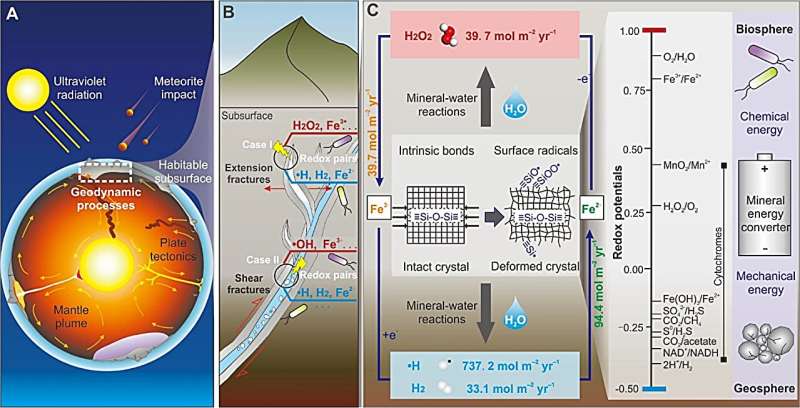Science
Study Reveals Energy Sources for Life Beneath Earth’s Surface

Chinese researchers have unveiled a groundbreaking discovery that challenges the long-standing belief that all life relies solely on sunlight. In a study published in the journal Science Advances on July 18, 2025, the team identified a novel energy source for life residing deep within the Earth’s subsurface, showing how microbes can thrive using chemical reactions linked to crustal faulting.
The research was spearheaded by Prof. He Hongping and Prof. Zhu Jianxi, both affiliated with the Guangzhou Institute of Geochemistry under the Chinese Academy of Sciences. Traditionally regarded as uninhabitable due to the absence of sunlight and organic matter, the deep subsurface has recently been recognized as a vibrant habitat teeming with diverse microorganisms. These organisms derive energy from abiotic redox reactions that occur during interactions between water and rocks.
A critical aspect of this research focused on understanding how these microbes produce energy. The team simulated crustal faulting activities and found that free radicals generated during rock fracturing are capable of decomposing water. This process produces hydrogen (H2) and oxidants, such as hydrogen peroxide (H2O2), which are vital for microbial metabolism.
Microbial Metabolism and Energy Production
The study revealed that in microbe-rich fractures, hydrogen production linked to earthquake-related faulting can be up to 100,000 times greater than that from other known energy pathways, including serpentinization and radiolysis. This substantial increase in hydrogen generation affects the redox cycle of iron, influencing essential geochemical processes involving elements like carbon, nitrogen, and sulfur. The findings indicate that these processes are crucial for sustaining microbial life in the deep biosphere.
Professors He and Zhu emphasized that the distinct redox gradients created in fracture systems could enable these microorganisms to thrive in environments previously considered hostile. They also highlighted the potential implications for astrobiology, suggesting that similar fracture systems on other Earth-like planets might provide habitable conditions for extraterrestrial life.
This research not only expands our understanding of life in extreme environments on Earth but also opens up new avenues for the search for life beyond our planet. As scientists continue to explore the depths of the Earth and beyond, this study underscores the resilience and adaptability of life in even the most challenging conditions.
For further details, the full study can be accessed through Science Advances, with the publication titled “Crustal faulting drives biological redox cycling in the deep subsurface.” The findings could pave the way for future research into both terrestrial and extraterrestrial life forms.
-

 Health3 months ago
Health3 months agoNeurologist Warns Excessive Use of Supplements Can Harm Brain
-

 Health3 months ago
Health3 months agoFiona Phillips’ Husband Shares Heartfelt Update on Her Alzheimer’s Journey
-

 Science2 months ago
Science2 months agoBrian Cox Addresses Claims of Alien Probe in 3I/ATLAS Discovery
-

 Science2 months ago
Science2 months agoNASA Investigates Unusual Comet 3I/ATLAS; New Findings Emerge
-

 Science1 month ago
Science1 month agoScientists Examine 3I/ATLAS: Alien Artifact or Cosmic Oddity?
-

 Entertainment5 months ago
Entertainment5 months agoKerry Katona Discusses Future Baby Plans and Brian McFadden’s Wedding
-

 Science1 month ago
Science1 month agoNASA Investigates Speedy Object 3I/ATLAS, Sparking Speculation
-

 Entertainment4 months ago
Entertainment4 months agoEmmerdale Faces Tension as Dylan and April’s Lives Hang in the Balance
-

 World3 months ago
World3 months agoCole Palmer’s Cryptic Message to Kobbie Mainoo Following Loan Talks
-

 Science1 month ago
Science1 month agoNASA Scientists Explore Origins of 3I/ATLAS, a Fast-Moving Visitor
-

 Entertainment2 months ago
Entertainment2 months agoLewis Cope Addresses Accusations of Dance Training Advantage
-

 Entertainment3 months ago
Entertainment3 months agoMajor Cast Changes at Coronation Street: Exits and Returns in 2025









